
Ancient Barolo
Saturday, November 22: Deborah dropped me at the airport at 8:30 pm for a 10:25 pm flight to Rome, from where our group would fly on to Sardinia. Skipped dinner onboard and went to sleep – very comfortable on Alitalia Business Class with seats that fold down supine.![]()
Sunday, November 23: Our delegation (three Quebec wine writers, two from BC, one from Ottawa and two of us from Ontario) arrived in Alghero at 4:30 pm. Two of the party lost their luggage between Rome and Sardinia, which put us an hour behind schedule.
A two-hour bus trip to Tempio Pausania in the north of the island for a visit to Cantina di Gallura. Sardinia has 1897 kilometres of coast and covers 24,000 square kilometres in total. There are 3,900 hectares of Vermentino planted on the island (5,200 ha. total in Italy, in Tuscany and Piemonte and Liguria where the grape is called Pigat).
Then on to a local restaurant – Hotel-Ristorante-Pizzeria Il Melograna da Claudio – for a huge dinner. We started with a magnum of Gallura Brut 2011 (Vermentino), a Charmat sparkler. Al the dishes included the local flat bread called carasau, very thin and crisp. A variation is made with olive oil and rosemary called guttiau.

Traditional Sardinian flatbread, carasau
We started with wild boar prosciutto on carasau, followed by orata (sea bream) marinated in almond milk with myrtle berries and red peppercorns. Then the dishes kept arriving: oysters, swordfish carpaccio, tuna tartar with black mushrooms, shrimps, bottarga salad, razor clams, fregole pasta with clams and artichokes and powdered fish roe and a plate of octopus. Then a whole dorade baked in salt and delivered flaming to the table. The accompanying wines: Cantina Gallura Vermentino Canayli 2013, Genesi Vermentino 2013 in magnum, Balanjana Bianco Colli del Limbara Vermentino 2010 (wood aged). With a dessert of baked goods, Cantina Gallura Modcati di Tempio Spumante. Finally, a digestif, Mirto di Sardegna Tremontis and grappa. After dinner, we transferred to the Hotel For You (yes, that was its name) in the town of Olbia and checked in at midnight.
Monday, November 24: Woke at 4 am this morning. So started working. Left the hotel at 9 am for a tour of Cantina delle Vigne di Piero Mancini in Olbia. Piero Mancini started out as a dentist.
- Piero Mancini Primo Vermentino Gallura Superiore 2013 (20% barrique aged for four months): pale straw colour with an earthy peach pit nose and a bitter almond finish. (87)
- Piero Mancini Vermentino di Gallura Spumante Brut 2013: dry, floral, peachy nose; minerally and perfumed. (89)
- Piero Mancini Monica di Sardegna 2012: the first time I’ve tasted this grape – ruby colour; a minerally nose of dried flowers and cherries; rustic plum and cherry flavours with 14% alcohol. (87)
- Piero Mancini Cannonau Falcare 2013: deep ruby colour; rustic, earthy raspberry and rose petal nose that replicate as flavours on the palate. Good lenght. (88)
- Piero Mancini Moscato di Sardegna Cucione: floral, honey and orange blossom nose; touch of sweetness in mid palate with a bitter finish. (88)
- Piero Mancini Pinot blanc Chardonnay Brut (50/50): green apple and apple core flavours with a bitter finish. (86)
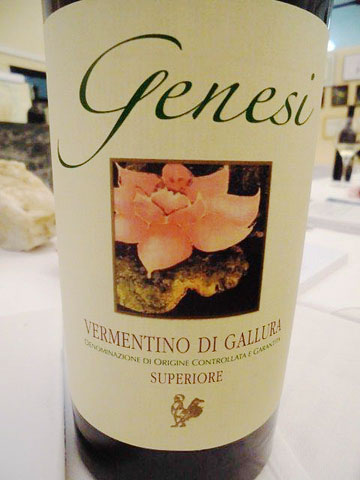
Cantina Gallura Vermentino 2013
Two hours later, a tour of Cantina Pedres in Olbia, owned by Giovanni Mancini. His wife Caterina and daughter Emanuela introduced his wines while he busied himself bringing in a buffet lunch.
- Pedres Spumante Brut: a dry Vermentino that tastes like a dry Muscat with an earthy note. (87)
- Pedres Thilibas Vermentino di Gallura 2013: peach pit nose, earthy, dry, bitter almond flavour with a short finish. (86)
- Pedres Cerasio Cannonau di Sardegna 2012: ruby colour; dry, plum and sour cherry flavours; rustic. (86)
- Pedres Muros Colli di Limbara 2012: Syrah/Cabernet Sauvignon/Merlot and Sangiovese – purple colour with a violet rim; herbal, black fruit nose with a floral note; dry and savoury. (87)
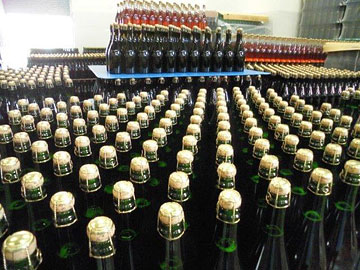
Spumante at Pedres
After lunch we departed for the town of Arzachena to visit Società Agricola Surrau. On the way we diverted to visit Porto Cervo on the Costa Smeralda. It was created by Prince Karim Aga Khan and various other investors. Porto Cervo has a resident population of 421 very wealthy inhabitants.

Porto Cervo, Costa Smeralda
The three brothers of the Demuro family, who own the Surrau winery, are big in construction and tourist resorts. They returned to their grandfather’s farm to create a stunning modern winery, which they named Surrau after the valley.
- Surrau Branu Vermentino di Galluria 2013: pale straw colour; minerally, white flowers and white peach on the nose; elegant, lovely mouth-feel, well balanced with good length. (89)
- Surrau Sciala Vermentino di Galluria Superiore 2012: floral nose of white peaches; leesy flavour, minerally, firm and well structured. (88)
- Surrau Late Harvest Sciala 2013: earthy, spicy, barnyard nose; full-bodied, funky flavour with a rich mouth-feel. (88)
- Surrau Cannonau di Sardegna Sincaru 2012 (14.5% alcohol): deep ruby colour; Zinfandel-like nose – vanilla oak, plum and leather; sweet black raspberry flavour, juicy and fresh; full-bodied, spicy with ripe tannins. Well-structured and sturdy. (90)
- Surrau IGT Isola di Nuraghi 2012 (Cannonau/Carignano/ Cabernet Sauvignon with 1% Muristellu): deep ruby colour; smoky, savoury, leather nose; full-bodied, rich and rustic; juicy fruit with good acidity. (89)
Surrau Barriu IGT Isola di Nuraghi 2011 (Cannonau/ Carignano/Cabernet Sauvignon with 1% Muristellu): dense ruby colour; spicy, raisiny, plum and blackberry jam on the nose; ripasso character, firm and muscular with a chunky mouth-feel. (90)

The wine bar at Surrau
Dinner: a series of plates of bottarga and celery salad, mozzarella and tomatoes, cheeses with honey, bresaiolo with arugula, salamis, ravioli stuffed with ricotta and lemon rind. Dessert: ricotta and honey with Surrau Sole di Surrau Vermentino Isola di Nuraghi Passito 2013 (medium sweet, fragrant, honey flavour but a little short on the finish (88)) and SurrauPassito Raju 2013 (dense ruby; pruny plum nose; medium sweet with a raisiny and spicy flavour (88)). Finally, Surrau Grappa Affinata.
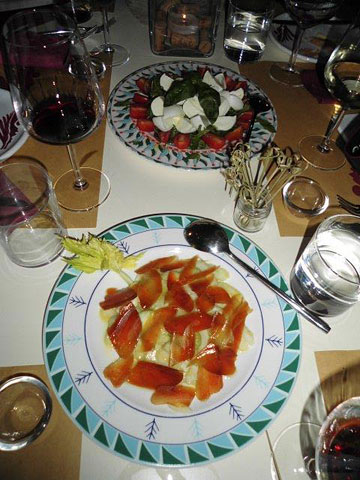
Bottarga and celery salad
Then the long drive back to Hotel For You in Olbia.
Tuesday, November 25: After breakfast we left with our luggage for Alghero to see Cantine Sella & Mosca – where we spent much of the day. The company was founded in 1899. In 1905 there were 1,671 grape varieties planted on the property. They are the only winery in Sardinia now growing Turbato. The soil is amazingly rocky here. In fact, it was a Stone Age necropolis (38 graves were found in the rocks). 520 hectares of vines planted in pergola fashion and on trellises. To dry the bunches for their passito they have 4 kilometres of grapes left outdoors on bamboo canes for 2–3 weeks. In 2002 Campari bought the company.
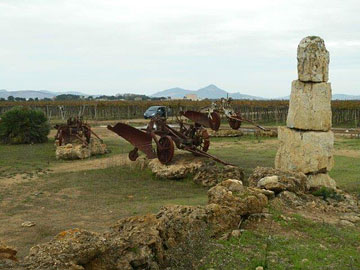
Stone fields at Sella & Mosca

Sella & Mosca winemaker Beppe Caviola
At the tasting before lunch I lost my notes because of a wrong keystroke on the computer; but I do recall the standout wine: Sella & Mosca Marchesi di Villamarina 2009. It would not have been out of place in a blind tasting of Second Growth red Bordeaux (93).

Sella & Mosca Marchese di Villamarina 2009
Before lunch we had an aperitif of Sella & Mosca Torbato Terre Blanche Cuvee 161 Vino Spumante Brut (fresh and easy drinking with a dry pear flavour and lively acidity (88)). The menu: spinach and “Rebetta apple” salad; Sardinian pasta filled with potato, cheese, fresh mint, in basil-flavoured tomato sauce; baked sea bream with potatoes and baked seasonal vegetables; selection of Sardinian sheep’s milk cheeses. Dessert: fresh fruit and pine nut tart. The wines: Sella & Mosca La Cala Vermentino di Sardegna 2013 (light straw colour; minerally, floral, peach bouquet; medium-bodied, fresh, white peach and citrus flavours; sweetish mid-palate flavour with a bitter almond finish (87)); Sella & Mosca Terre Bianche Torbato Alghero 2013 (straw colour; minerally, white flowers on the nose; dry and brad on the palate with some sweetness and a bitter finish (87)). With the cheese, the Marchesi di Villamarina 2009 tasted earlier. Dessert wine: Sella & Mosca Monteluce Alghero Nasco Passito 2011 (my first taste of the Nasco variety unique to Sardinia – old gold colour; high toned nose of pineapple, barley sugar and honey; full-bodied sweet peach flavour (89)). A long drive back to Alghero to check into the Hotel Catalunya.
Wednesday, November 26: Checked out of the hotel for our hour-long flight to Milan where we took another bus to Canelli in Piemonte for a welcome reception to Piemonte at Cantine Coppo. We toured Coppo’s underground “cathedral” – part of a series of 18 kilometres of caves, tunnels and rooms carved out of the calcareous tuff and brick-covered under the streets of Canelli (now a UNESCO world heritage site). Perfect conditions for storing Asti Spumante. At noon, a Tasting Experience and buffet lunch (duck pasta, slow-cooked beef with Barbera and clove-flavoured sauce) at Ristorante dell’Enoteca Regionale di Canelli. Tasted the following wines:
- Poderi Luigi Einaudi Dogliani Dolcetto 2013: dense purple colour with a violet tint; earthy, black cherries; fruity, dry, with lively acidity and a bitter finish. (88)
- Coppo Barbera d’Asti L’Avvocata 2013: deep ruby; cherry with a gamey note on the nose; dry, firm structure, strong strain of acidity, cherry pit flavour with a floral note. (88+)
- La Gironda Le Nicchie Barbera d’Asti Superiore Nizza 2011 : dense purple ruby colour; spicy, vanilla oak, black cherry, meaty with a leather note; full on the palate, fruity and richly extracted, dark chocolate with lively acidity. (90)
- Ciabot Berton Langhe Nebbiolo 3 Utin 2012: tawny ruby; minerally, rose petal, licorice, blackcurrant nose with an earthy note; sweet fruit, firmly structured, elegant and majestic, evident tannins. (91)
- Fratelli Serio & Battista Borgogno Cannubi Barolo Riserva 2008: deep, tawny ruby colour; creamy, blackcurrant nose; firmly structured, earthy, dry, plummy with a tannic needs time. (92)
- Cerutti Moscato d’Asti Canelli “Surì Sandrinet” 2013: orange, honeysuckle nose; semi-sweet, well balanced, clean and fresh, grapey. Easy drinking. (90)
Next stop, Cantina Marchesi Alfieri in San Martino Alfieri. A magnificent Baroque property dating back to 1692, now a luxury hotel and B&B.
- Marchesi Alfieri La Tota Barbera d’Asti 2011 (magnum): deep ruby colour; leather, cherry nose; elegant, lovely mouth feel, dry with fresh acidity. (90)
- Marchesi Alfieri La Tota Barbera d’Asti 2012: deep ruby colour; earthy, herbal, leather, cherry nose; richer on the palate than 2011 with a smoky, tarry note. Full on the palate.
- Marchesi Alfieri Alfiera Barbera d’Asti Superiore 2011 (magnum): dense purple-ruby colour; vanilla, cherry, mineral note; rich and velvety, cherry liqueur flavour. (91)
- Marchesi Alfieri Alfiera Barbera d’Asti Superiore 2007 (magnum): dense purple-ruby; dry, mature cherry nose with spice; dry, well balanced, firm with licorice, cherry and balsamic notes. (91)
- Marchesi Alfieri Alfiera Barbera d’Asti Superiore 2005 (magnum): dense ruby-purple, youthful looking; forest floor, leather, cherry nose; austere and dry, dry and firm with firm tannins and angaging floral note on the back taste. (92)
- Marchesi Alfieri Costa Quaglia Monferato Nebbiolo 2010: ruby colour; dried rose petal, dried herbs, spicy, cherry nose; dry, earthy, firmly structured, herbal and savoury. (90)

200-year-old grape vine at Marchesi Alfieri
After a quick visit to the old cellars and the 200-year-old vine that grows in the courtyard of the castle, we bussed to Azienda Vitivinicola Bava – Giulio Cocchi Spumanti in Cocconato. Unfortunately, my old friend Roberto Bava was returning from China and wouldn’t be back at the winery until 11:30 pm. His younger brother Paolo conducted the tasting. The family owns 52 hectares of vine. The two companies, Bava and Cocchi (spumantis and wine-based aperitifs and vermouth), produce half a million bottles a year. Roberto Bava once told me, “We don’t sell wine; we sell emotion.”
- Cocchi Bianc ‘d Bianc Alta Langa Brut 2008 (100% Chardonnay): pale straw with tiny bubbles; dry, earthy, apple flavour. (88)
- Cocchi Rösa 2008 (100% Pinot Noir): pink with a bluish tint; cherry pit nose; dry, austere, sour cherry flavour. (88+)
- Bava Thou Bianc Chardonnay 2013: pale straw; minerally, herbal, earthy nose; dry, crab apple flavour tinged with herbs. (86)
- Bava Ruchè di Castalogne Monferrato 2013: ruby colour; floral, spicy, medium-bodied, dry, medium-bodied with a bitter, tannic finish. (87)
- Bava Barbera d’Asti Superiore Stradivario 2009: deep purple-ruby colour; floral, herbal, graphite, black cherry nose; rich and full on the palate, dry with lively acidity and a flavour of blackcurrants. (90)
- Bava Barbera d’Asti Superiore Stradivario 2001: deeply coloured, purple; dry, savoury nose, herbal; lovely texture, rich, spicy, dry plum and cherry flavours; nicely resolved tannins. (91)
- Bava Barolo Scarrone 2007: mature ruby; rose petal with a tarry note on the nose; beautifully integrated, rich and full on the palate. Great balance. (92)
We ended the tasting Cocchi Americano Aperitivo.
A two-hour drive back to Alba to check into the I Castelli Hotel in Alba. While the rest of the group went on to a dinner with winemakers at Ristorante La Crota in Roddi, Rod, Steve and I opted to have a quiet meal and went looking for a pizza place. We found Sole Mio Ristofiziopizzeria and ordered delicious pizzas with a bottle of Barbaresco 2010 specially bottled for the restaurant. Got to bed by 10:30 pm.

The town of Barolo
Thursday, November 27: A great night’s sleep, the first since arriving in Italy. On the way to visit Domenico Clerico in Monteforte Alba, our guide Sandro, a sommelier, pointed out the Ferrero factory where they make Nutella and Ferrero Rocher. He also told us about a new documentary called Barolo Boys – about an association of 15 top producers plus one woman who also sponsor the local Monforte soccer team. Their jerseys are, of course, the colour of Barolo.
There are 350 Barolo producers, 500 including those who buy the wine and bottle it themselves. Sandro also told us about the history of Barolo. Until the mid-19th century Barolo used to be a slightly sweet and slightly sparkling wine. It was Marchese di Barolo, Carlo Tancredi Falletti, who made the first modern Barolo and called it after the name of the village where he lived. And how, in the 1960s, the sons of producers wanted to revolutionize the family business by dropping fruit to concentrate the wine. The idea was blasphemous to the older generation and many young winemakers were banished to create their own wineries. Sandro pointed out “the university for truffle hunting dogs” where they are trained to sniff out the tubers.

Domenico Clerico winery

Domenico Clerico
We arrived at Domenico Clerico in Monforte d’Alba. The new winery looks like an airline terminal. Oscar Arrivabene, the winemaker, conducted the tasting in the presence of his boss.
- Domenico Clerico Langhe Dolcetto Visadí 2013: deep purple colour; fruity, black cherry nose; dry, cherry flavour with lively acidity, ripe and delicious. (91)
- Domenico Clerico Barbera d’Alba Trevigne 2012: deep ruby-purple colour; creamy, spicy, vanilla, red berry fruit; fresh, beautifully balanced, elegant and seamless. (92)
- Domenico Clerico Barolo Pajana 2010: ruby with a tawny hue; vanilla oak, violets, dried cherries with a spicy-smoky note; well structured, powerful and full on the palate, dry, beautifully balanced with a firm tannic finish. (Ginestra cru) (92–93)
- Domenico Clerico Barolo Ciabot Mentin 2010: another Ginestra cru. Muted compared to Pajana on the nose, firm and tight; dry, cherry flavour, austere but noble. Needs time. (91–93)
- Domenico Clerico Barolo Aeroplanservaj 2008: tawny ruby; spicy, cherry nose with vanilla and leather notes; intense, firmly structured, licorice and cherry flavours. (92)
There is a good story about how this wine name came about. Domenico tells it on his website: “The name of the wine had to be the mirror of a past that is reflected in the present, and I thought there was nothing more meaningful than the nickname my father gave me: the translation in Piedmont dialect of Wild Aeroplane. The name perfectly embodied what my father saw in me: a child, a boy, and then man a who flies over the surrounding hills in his imagination and lands, sometimes, for a few moments to be part of the real world.” - Domenico Clerico Barolo Percristina 2007: deep ruby with a tawny hue; licorice, cherry, herbal note on the nose; dry, elegant, firmly structured with evident tannins. (92)
- Domenico Clerico Barolo Perchristina 2005: deep ruby with a tawny note; mature, spicy, tar, rose petal nose; elegant, lovely mouth feel, firm on the palate with a banana skin note on the finish. (94)
The tasting ended with a glass of Gosset Champagne as a palate cleanser.

Label with a story

My top Barolo of the trip
We drove around the Barolo region and ended up in Verduno for a tasting at Castello di Verduno, today a winery, an hotel and a restaurant called Ca’ del Re. The winemaker, Mario Andrion, led us through the following wines.
- Castello di Verduno Basadone 2013 (Pelaverga piccolo): light ruby colour; cherry, tar and white pepper nose with a floral note; fruity, raspberry flavour with lively acidity and a tannic lift on the finish. Beaujolais-like (88). Eleven producers of this rare variety; less than 30 hectares planted.
- Castello di Verduno Dolcetto Campot 2013: purple-ruby with a violet tint; earthy, black cherry nose with a floral note; fruity, perfumed, medium-bodied, fresh and easy drinking; almond note on the finish. (89)
- Castello di Verduno Langhe Nebbiolo 2013: ruby colour; roses, cherry on the nose with a barnyard note; dry, light on the palate, fruity and floral with an engaging freshness. (89)
- Castello di Verduno Barbaresco Rabajà 2006: deep ruby colour; dried cherries, minerally nose with floral accents; medium-bodied, dry, firmly structured, very elegant, chalky tannins on the finish. Drinking beautifully now but should be magnificent in five years. (92–94)
- Castello di Verduno Barolo Montvigliero Riserva 2006: deep ruby with a tawny hue; roses, cherries; medium-bodied, firmly structured, silky mouth-feel, elegant, a majestic wine with wood accents. Great length. (93)
We lunched at the Castello’s restaurant, Ca’ del Re. Accompanying the opening dish of veal tartar with slivers of sheep’s cheese we had the white version of Pelaverga – Castello di Verduno Pelaverga 2013 (pale straw colour; a nose of peaches and white flowers with a thread of minerality; green pineapple flavour with lively acidity (88)). Next course, cream cheese discs with olive paste, followed by pumpkin risotto and blue cheese. Then chocolate ganache for dessert with grappa.

The door to Castello di Verduno

Ancient Barolos in Castello di Verduno’s cellar
Bussed to Michele Chiarlo’s resort (a collection of farm houses that was converted into a spa). A 1720 building houses an enoteca with many vintages of the best Barolo producers. The tasting was held in a very contemporary room,
- Michele Chiarlo Gavi Le Marne 2013 (100% Cortese): pale straw; minerally, herbal nose; dry, peach pit flavour with a bitter almond finish. (88)
- Michele Chiarlo Barbera d’Asti Superiore Le Orme 2012: ruby with violet note; cherry, earthy-leafy nose; dry, medium-bodied, lively acidity, firmly structured. (87+)
- Michele Chiarlo Barbera d’Asti Superiore Cipressi della Court 2012: ruby with violet note; floral, minerally, cherry nose; dry, fresh, good expression of cherry fruit, well balanced with a fine mouth feel. (89+)
- Michele Chiarlo Barbaresco Reyna 2010: mature ruby colour; woody, floral, cherry nose; dry, blackcurrant flavour, fruity, spicy and firm. (89)
- Michele Chiarlo Barolo Tortoniano 2010: mature ruby colour; earthy, spicy, cherry; mouth-filling, peppery, dry, firmly structured, dried cherries. Good texture. (90)
- Michele Chiarlo Barolo Cerequio 2004: mature ruby but holding colour well; vanilla oak, creamy, spicy, minty nose with a chestnut note; velvety mouth feel, dry, beautifully structured, black cherry, currant and licorice flavours; still youthful. (93)
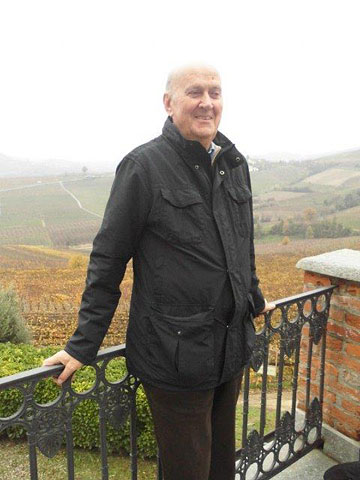
Michele Chiarlo
Visit to the wine museum in the town of Barolo’s Falletti Castle, known locally as WiMu, “an interactive voyage through culture and wine traditions.” Then on to Fratelli Serio & Battista Borgogno on the top of Cannubi hill for another tasting.
- Fratelli Serio & Battista Borgogno Nebbiolo d’Alba 2011: ruby colour; spicy, dried cherries with an oak note; dry, lean and sinewy with evident tannin. Old style Nebbiolo. Needs time. (88–89)
- Fratelli Serio & Battista Borgogno Barbera d’Alba Superiore 2010: deep ruby; dried roses, dried cherries on the nose; dry, medium-bodied, lively acidic spine, lean and tight. Austere but well balanced. (88)
- Fratelli Serio & Battista Borgogno Barolo Cannubi 2009: ruby with a tawny hue; light floral note, dried cherries with an oak note on the nose; dry, firmly structured, austere – built to age. (88–90)
- Fratelli Serio & Battista Borgogno Barolo Cannubi Riserva 2008: ruby with a tawny rim; leather, tobacco, dried red fruits; old style Barolo, dry, sinewy with evident tannins. (89)
- Fratelli Serio & Battista Borgogno Barolo Cannubi Riserva 2007: licorice, dried cherries, spicy, leather nose; sweet cherry fruit with a floral grace note, firmly structured, good mouth feel with a tannic build-up on the finish. Needs 7–10 years. (89–91)
- Fratelli Serio & Battista Borgogno Barolo Cannubi Riserva 2005: mature ruby colour; tobacco, chestnut, dried cherries on the nose; dry, gripping tannins, well-structured but needs time (at least 5 years). (89–91)
- Fratelli Serio & Battista Borgogno Barbaresco 2011: ruby with a mature rim; chestnut, dried red berry fruit bouquet; sweet fruit, well extracted, full on the palate, lovely floral note, firm structured. (90)
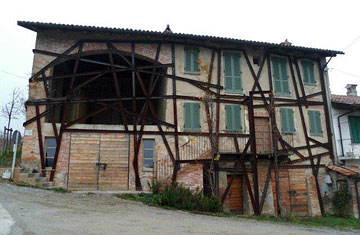
Angelo Gaja’s property in Barolo
Dinner at Ristorante Ca’ del Lupo in Montelupo Albese to meet four winemakers from the region. The menu: Mixed salad with Guinea fowl, vegetables and balsamic vinegar; Pumpkin and gorgonzola crepes; homemade fettuccine with sausage; Fassone veal bites in Barolo with roast potatoes; and for dessert, Nougat parfait with chocolate sauce. The wines:
- Tenuta Carretta Gayega Rorero Arneis 2013: pale straw colour; mineral, smoky, citrus and peach nose with notes of struck flint; richly extracted peach flavour; full in the mouth with good length. (89)
- Poderi Moretti Rorero Arneis Occhetti 2013: straw colour; minerally, leesy, peach nose; perfumed, white peach and citrus flavours. (88)
- Malvira Rorero Arneis 2008 (10% oak aged): golden straw colour with a spicy, minerally, ripe; richly extracted and full on the palate with a tropical fruit nose; full in the mouth with pineapple and citrus flavours. Great length. (91)
- Montalbera Ruché di Castagnole di Monferrato 2013: ruby with a violet hue; rose petal and cherry nose; peppery, pomegranate flavour, lively on the palate with a tannic note on the finish. (89)
- Azienda Agricola Runchet Barbera d’Alba 2013: dense purple-ruby colour; earthy, fruity, vanilla oak nose with a spicy top note; dry and fruity with plum and cherry flavours carried on lively acidity. New World style. (89)
- Poderi Moretti Nebbolo d’Alba Occhetti 2011: deep ruby colour; high-toned nose of cherry, oak and grapefruit rind; well extracted fruit with good acidity. Cherry jam flavour but dry with a savoury finish. (89)
- Azienda Agricola Runchet Langhe Nebbiolo 2013: deep ruby colour; lifted floral, black cherry and blackcurrant nose with spicy vanilla oak; richly extracted, firm cherry flavour with evident but supple tannins. (90)
- Tenuta Carretta Barbaresco Garassimo 2011: deep ruby colour; spicy, struck flint, cherry and vanilla oak on the nose; clove and cherry flavours, firmly structured with a tannic lift on the finish. (90)
- Tenuta Carretta Cascina Ferrero Barolo 2010: deep ruby colour; struck flint nose with floral, peppery, cherry notes. (First bottle was mildly corked – second was much better with nicely balanced ripe fruit.) (89)
- Malvira Roero Nebbiolo Superiore “Trinita” 2001 (in magnum): deep ruby colour; rose petal. Pencil lead and cherry nose; very elegant, well balanced, firmly structured with a tarry note and grainy tannins. A lovely wine with still lots of life. (93)
- Poderi Moretti Rorero Ginis Riserva 2006 (Nebbiolo): deep ruby colour; creamy, cherry nose; modern style – fruity and full on the palate, velvety mouth fee. (89)
- Azienda Agricola Runchet Moscato d’Asti 2013: very pale colour; honey and orange blossom on the nose; light, elegant, clean and grapey. (89)

Malvira’ Roero Nebbiolo Superiore “Trinita” 2001 (in magnum)
Friday, November 28: Our first stop was Azienda Agricola Rivetto within sight of the Serralunga castle. The young 4th generation winemaker, Enrico Rivetto, showed us the sparkling Nebbiolo he’s working on. The grapes were cut a thumb’s length from the tip of the bunches. The wine, spending 42 months on the lees, will be called “Nebbione.” Five other producers in this region and in Gattinara and Val d’Aosta are working on this concept. Enrico also is experimenting with fermentation in a 400 litre terracotta amphora. He also makes the rare Nascetta, the only white grape native to the Langhe.
- Rivetto Langhe Nascetta 2013: golden straw colour; minerally, peach nose with an aromatic note; soft mouth feel, dry with lively acidity, white peach and lemon rind, grassy flavours. (88+)
- Rivetto Langhe Nascetta 2012: golden straw colour; spicy, peach pit nose; Viognier-like with fresh acidity. (88)
- Rivetto Barbera d’Alba Zio Nando 2011: dense ruby-purple colour; cedar, black cherry nose; rich, ripe and full black cherry flavour with hints of vanilla and all-spice. (89)
- Rivetto Barbera d’Alba Loirano Soprano 2011 (top part of the Loirano hill; 100% French oak): dense purple colour that stains the glass; firmly structured, showing a lot of oak at the moment, but the black fruit flavours are there and will express themselves with a couple of years of ageing. Fine spine of acidity. (89–90)
- Rivetto Barolo Serralunga d’Alba 2010: mature ruby colour; earthy-spicy, vanilla, black cherry nose; dry, richly extracted, firmly extracted with evident muscular tannins; new style Barolo (89–91)
- Rivetto Leon Riserva 2008: deep ruby colour; licorice, black cherries with a floral note; elegant, beautifully balanced, firm structure, with chewy tannins. Needs time. (90–92)
- Rivetto Barolo Briccolina 2009: mature ruby colour; chestnut, cherry nose with a floral note; dry, elegant, firm structure, dry, soft tannins but built for ageing. Lovely floral note on the finish. (92)
- Rivetto Barolo Serralunga d’Alba 2009: mature ruby colour; dried rose petals, cherry with an earthy note; dry, elegant, firmly structured, evident tannins with a licorice note. Needs five years. (90)
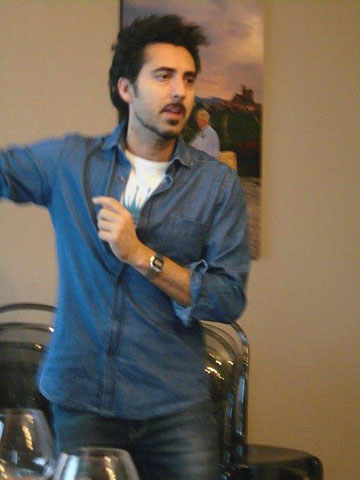
Winemaker Enrico Rivetto
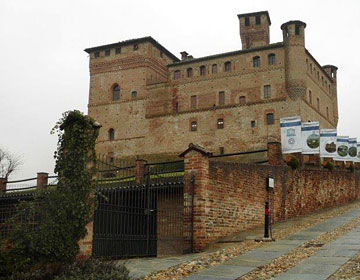
Castello di Grinzane
After visiting Rivetto we bussed to Castello di Grinzane (another UNESCO World Heritage Site) where Cavour lived. Then on to an organic winery, Azienda Agricola Ressia in Nieve where we had a lunch tasting (the wines by Fabrizio Ressia and the food, a typical local menu, prepared by his mother). Tonnato vitello, Toma cheese, lettuce and walnut salad, salamis and lardo, Russian salad with tuna and roasted peppers with anchovy and capers.
- Ressia Dolcetta d’Alba Canova 2013: ruby colour; floral, cherry nose; old style, rustic. Medium-bodied, dry and fresh, Beaujolais-like. (88)
- Ressia Barbera d’Asti Superiore 2011: ruby colour; floral, cherry nose; sweet fruit, soft on the palate with an engaging blackcurrant flavour; soft tannins. (Aged in barrels with French staves and Slovenian ends). (89)
- Ressia Ressiot 2011 (a blend of Barbera d’Alba, Nebbiolo di Barbaresco and Merlot): ruby colour; cooked cherries on the nose with a floral note; good mouth feel, dry with lively acidity, dry plum and cherry flavours with a tannic finish. (88+)
- Ressia Lanche Nebbiolo Gepu 2011: ruby colour; vanilla, sweet cherry; fruity and full on the palate; firmly structured, earthy with ripe tannins. Rustic, (88)
- Ressia Barbaresco Canova 2011: ruby colour; minerally, cherry pit, tobacco nose; creamy mouth feel, dry, minty, cherry, easy drinking. (89)
- Ressia Barbaresco Riserva Oro 2009: ruby coloured; mature, spicy cooked cherries and rhubarb nose; dry, elegant, well integrated oak. Old style, cherry and tobacco flavours with firm tannin. (Pre-phylloxera vineyard, a clone of Barbaresco planted 1999. Only made in 2005 and 2009.) (89)
Next stop, Gigi Rosso in Castiglione Falletto, in the centre of the Barolo region. Maurizio Rosso, married to a Californian, conducted the tasting. He told us Barolo produces 13 million bottles while Barbaresco produces 3.5 to 4 million.
- Gigi Rosso Rorero Arneis 2013: pale straw with a lime tint; high toned, minerally, green peach; medium-bodied, green pineapple with lively citrus acidity. (89+)
- Gigi Rosso Dolcetto Diano d’Alba Vigna Vecchia del Pinnacolo 2012: rose petal and cherry nose; dry, sour cherry with a hint of bitter almond on the finish. Firm structure, tannic lift on the finish. (89)
- Gigi Rosso Barbera Superiore Vigna del Cavallo 2010: dense purple colour; pencil lead, dark plum with oak notes; rich and full on the palate with exciting acidity; well integrated oak; firm finish. (89+)
- Gigi Rosso Barolo Arione 2010: ruby with an orange rim; tea, rose petal, cherry; elegant, forward, beautifully balanced with ripe tannins and a long lingering finish. (91)
- Gigi Rosso Barolo Arione Riserva dell’ Ulivo 2007: ruby colour; tobacco, cherry, cedar nose; sweet fruit with a cherry and blackcurrant flavour; firmly structured, elegant and confined at the moment. (90–92)
- Gigi Rosso Langhe Rosato 2013 (Nebbiolo): pale salmon colour; minerally, cherry pit and banana skin nose; flavourful, strawberry and rhubarb; full in the mouth with structure. Easy drinking with a touch of bitterness on the finish. (88+)

Winemaker Maurizio Rosso
Dinner in Monforte d’Alba at Ristorante Le Case della Saracca. The restaurant is carved into the side of a hill, on several levels, with tiny rooms. When I saw it I realised it was the same restaurant our Pauwels group dined in in May 2012. There were two wine producers there and a guy who headed the truffle association who spoke to our group about the cultural importance of truffles to Piemonte (but there were no truffles served with the meal!). We started off with vitello tonnato (again), followed by a Jerusalem artichoke flan with a sauce of olive oil, cream and anchovy, then ravioli stuffed with spinach and pork in a butter and thyme sauce, then roast veal, French fries, grilled cabbage, eggplant and red peppers. Dessert, chocolate cake. We tasted the wines of Olivero Mario, Poderi Ruggeri Corsini, and a magnum of Domenico Clerico Bricotta Barolo 2009 (a richly extracted, spicy fruitcake of a wine with black cherry, blackcurrant and licorice flavours; firmly structured, elegant with well integrated oak (92)). Got back to the hotel at 12:30 am, packed and slept till the wake-up call at 7 am.
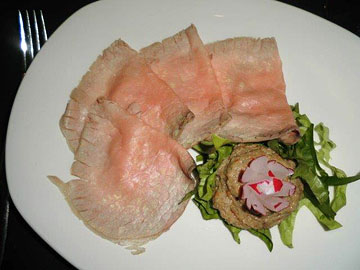
Vitello tonnato
Saturday, November 29: Our group was bussed to Torino airport for the flight to Rome. The transit lines at Fiumacino Airport were horrendous so I used my British passport to get through the EU passport line. There were almost fist-fights in the other line as passengers tried to get through the electronic controls. From Rome we flew to Toronto.

Reblogged this on Jade D'Cruz and commented:
Italian wine – a great post!
Pingback: The insider’s guide to Sardinian wine | Cool-Pads